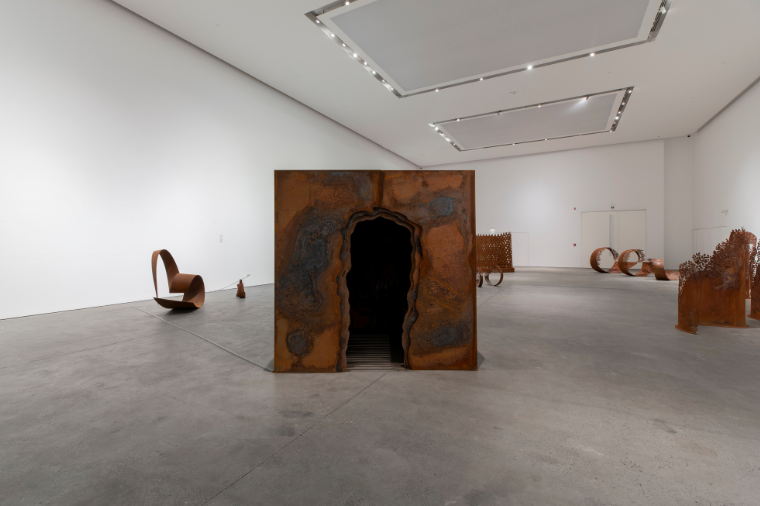Leila Heller has gained worldwide recognition as a pioneer in promoting creative dialogue in this part of the world and globally.
After opening its first international location in Dubai’s Alserkal Avenue, this one-of-a-kind art gallery leaves a lasting impression on contemporary art and culture here in the Middle East.
To understand more about the process of art curation, Emirates Woman spoke to Leila Heller, founder of the gallery about her approach to art.
Talk us through your approach to curating an art collection.
Collecting is definitely an art in itself and one has to be focused on the oeuvre and progression of artists they are collect- ing. There should be a theme or connection between the artists in one way or another. Personally, as a woman, I collect many female artists or art that has women as the subject. Some examples include Shirin Neshat, Marilyn Minter, Soraya Sharghi, Francesca Pasquali, Nan Swid, Mia Fonssagrives Solow, Rachel Lee Hovnanian, Ran Hwang, Mouna Rebeiz, Reza Derakshani, Gulay Semercioglu, Rob Wynn, Melis Buyruk, Hadieh Shafie, Aref Montazeri, and Ana D’Castro. I love abstraction but also texture and my collection have largely become based on materiality and what the work is made of. I also have a theme of modernist artists and contemporary masters such as Damien Hirst, Keith Haring, Andy Warhol, Fernand Leger, Andre Lhote, Claudia Bravo, Marcos Grigorian, Manoucher Yektai, Farideh Lashai, Henry Moore, Gleize, Renoir, Matisse, and more.
View this post on Instagram
What advice would you impart to those starting their art collection?
My biggest advice to art collectors is to love the work you buy. It has to be love at first sight. Then you do your research. Is it in a museum collection, part of biennales or curated shows? This shows the probability of the artist’s success going forward. But first and foremost, it must start with a passion and gut feeling.
What is the most recent piece the gallery has added to its art collection?
One of the most re- cent works I have added to my collection is Efe Alatin and Melis Buyruk, two Turkish artists who I have added personally to my collection but also to the gallery’s roster of artists.
NFTs have rewritten the rules of the game. How has this impacted the art world?
They became a craze but like many other trends, they have stabilised. Nonetheless, they have now been written into the canon of art history and definitely speak to this new age of technology. How do you suggest collectors take care of their pieces? In order to keep works of art in perfect condition for years to come, the best is to make sure they are not exposed to extreme temperatures of heat or cold as that can damage paintings, works on paper, and sculptures. Additionally, any work on paper should be behind a museum glass so that any sunlight does not discolour the paper and any bronze or metal sculptures should not be exposed to extreme humidity as they may rust. When cleaning art a feather duster is a good idea to gently remove dust from sculptures and paintings. No chemical cleaners or solutions should be used to clean any artwork at home.
What value can working with an art consultant have on the curation process?
This is a tricky question as there are different types. I know many extremely professional art advisors who are very educated in the field of art and have great experience working in museums, galleries, or other respectable art venues. Then there are others who call themselves art consultants without true knowledge of the art world, art history, or the art market, but use their connections to sell art. There are very honest and straightforward art advisors who have a fee structure they discuss with the client in advance and try their best on behalf of their client to negotiate down the price. However, there are many art consultants who get fees from both sides which aren’t done professionally. It is misleading in every way and prejudicial as they are paid from both sides. An art consultant can impose their own views on their client, so a client has to be aware and do their own due diligence and research to make sure it is a beneficial purchase. Some- times art consultants can be biased in their recommendations due to financial gain. How- ever, I do work with many art consultants who are extremely knowledgeable and helpful to both the buyer and the seller. If one would like to hire one, they should make sure to do their research to find a reputable person.
View this post on Instagram
What is your approach to art curation for an event?
As I have worked in several museums, I have been trained as a curator. This experience has been a big help to me in curating my own shows in the gallery or curating shows in other venues and locations. I will come up with a concept or idea, and every artist I choose has a connection to the theme. A well-curated exhibition is a delight to view and a badly curated exhibition can be a detriment to the exhibition and the artist it features. Every show in my gallery, unless I have a guest curator, is curated by myself and I take great joy in doing so. The placement is all hand-chosen by me and I try to always find the synergy between each work included. When I work with a collector, I also often curate the works in their home, placing the works to create a dialogue between them and ensuring everything flows. Lighting and framing are big components of a well-curated exhibition. Works need to have room to breathe and show themselves in all of their glory to create a cohesive presence.
November’s – The Collectors Issue – Download Now
– For more on luxury lifestyle, news, fashion and beauty follow Emirates Woman on Facebook and Instagram
Images: Supplied











